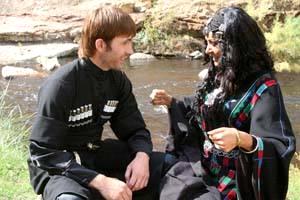Ammon News - By Thameen Kheetan
AMMAN - A recently released film tackling the historical relations between Jordan’s Circassian and bedouin communities at the turn of the 20th century has received mixed reviews in Amman.
Many viewers have praised “Cherkess”, saying that the two-hour movie gives a “realistic” depiction of life at the time, while a prominent tribal leader slammed the film for being “far from reality”.
Produced and directed by Mohydeen Quandour, a Jordanian filmmaker of Circassian origin, the film depicts several conflicts between the two communities in the early 20th century, when later waves of Circassian immigrants reached Amman after leaving their homeland in parts of Caucasia in Eastern Europe.
One of the differences depicted by the film arose when Circassian newcomers attempted to live near the capital’s freshwater springs in Ras Al Ain, a breach of an agreement between the two communities stipulating that no one should reside in the area to keep the water source available for all.
The film also centres around a fictional love story between a bedouin woman and a Circassian man who elope after her parents oppose their marriage. Although elopement is part of Circassian traditions, it is considered an insult to family honour by bedouins.
Despite the cultural differences, the conflict between the two communities was exaggerated, according to tribal leader Ghazi Al Fayez.
“The film is far from reality because there wasn’t any confrontation between Circassians and bedouins,” Fayez told The Jordan Times over the phone Thursday, adding that “such an incident never happened in reality”.
He noted that the relationship between the Circassians and the bedouin tribe of Bani Sakher, to which he belongs, was “strong and close from the very beginning”.
Fayez, who attended the movie premiere on Sunday, thanked the filmmaker for “showcasing bedouin and Circassian norms of generosity and bravery”, but said that Quandour “had to be more accurate” in narrating historical events.
Several historians have stated that the beginning of the 20th century witnessed many conflicts between the two communities; one of these is the 1908 Balqawiyyeh War.
Fayez said the conflict actually refers to a confrontation between Circassians and residents of the Balqa area, who were villagers and not bedouins.
“There were no villagers at that time,” Quandour said in defence of his film, claiming that the original residents of Transjordan were all bedouins.
“There were many conflicts then,” he told The Jordan Times in a phone interview Thursday, explaining that he invented the love story for the sake of dramatic effect.
When crafting the script, the Hollywood director said he referred to a series of historical references written on the Kingdom’s Circassian community.
He said the film aims to promote the principle of dialogue as a means to resolve conflicts between people.
“The message is quite simple: Any conflict between cultures or civilisations can be solved with wise dialogue,” Quandour remarked.
Starring Sahar Bishara and Azamat Bekov, the JD2 million film is in Arabic and Circassian with English subtitles.
Sunday’s premiere was attended by members of the Royal family, officials, critics, journalists, intellectuals and Circassian and bedouin community leaders.
Apart from the criticism by Fayez, the film, which is open to the public, has received warm reviews from Jordanians of Circassian and bedouin origins alike.
“I liked the film; it reflects the reality without exaggeration, and at the same time it does not hide the facts,” said Zaid Hakki, a 23-year-old Circassian after a screening on Wednesday evening.
Another young Circassian man, Tamer Qunash, said the filmmaker succeeded in showing how both cultures first met in Amman and “how things became normal afterwards”.
“The film really depicted the reality,” noted Reem, a 28-year-old woman of bedouin background.
Circassian researcher Mohammad Azoka agreed, saying that a “misunderstanding occurred when the two cultures met, and that is a natural thing”.
He said the Circassian population in Jordan, which is now estimated at around 200,000, first came to the country in 1878. Waves of Circassian immigration continued up until 1906, Azoka noted.
(Jordan Times)
** The leading actors of Jordanian movie ‘Cherkess’ are seen in one of the film’s shots (Photo courtesy of Cherkess executive producer Essam Hijjawi)
